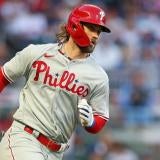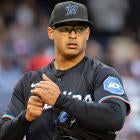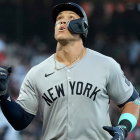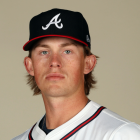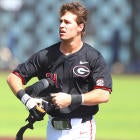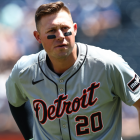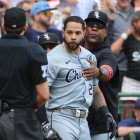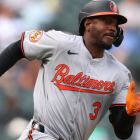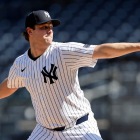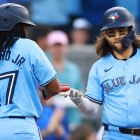For the first time since moving out west following the 1967 season, the Oakland Athletics have finished last three years in a row. Last season, however, represented a step in the right direction -- and not just because they broke the 70-win threshold. Rather, the A's graduated a number of players who could be part of their next winning team.
There's a chance that next winning team doubles as the 2018 Athletics. Though expectations are modest -- PECOTA says 76 wins; FanGraphs 78 -- there's reason to think the A's could be better than that, and could be nearing their next competitive upswing. Here's why.
The vitals
2017 record: 75-87 (minus-87 run differential)
2018 depth chart: Click here
2018 schedule: Click here
Fantasy preview: Click here
A promising lineup
From an OPS perspective, last season's offense was the best the A's have had since 2013, when they won 96 games. Blame it on the juiced ball, the talent, or both, but the A's had nine players achieve double-digit home runs. That includes Khris Davis, who led with 43; Yonder Alonso, who was traded after 100 games; and Matt Olson,who hit 24 in 59 games. Alonso and Ryon Healy are gone, but the A's retained the other seven and added Stephen Piscotty from the St Louis Cardinals, who hit 22 dingers in 2016. This group is built to slug.
Between Piscotty (who signed a team-friendly deal while with the Cardinals), Olson, and third baseman Matt Chapman, the A's have the makings of a nice cost-controlled core, too. Chapman in particular could become the face of the franchise -- he's an elite-level defender at the hot corner, as well as a capable hitter who could offer league-average or better production. Each of those three could be with the A's through at least the 2022 season. Nifty.
Also nifty: Jed Lowrie's resurgence and the Jonathan Lucroy signing leaves just one possible dim spot in the A's lineup: in center field, where Boog Powell is likely to give way to Dustin Fowler sooner than later. Otherwise, this is a group that has the potential to pester opposing pitchers.

The unknown is an opportunity
Despite what Hollywood suggested, the A's at their greenest were led by Tim Hudson, Barry Zito, and Mark Mulder. Those three aren't walking through the doors anytime soon, but the A's have a chance at running out some interesting starters in the near future. "A chance" because at the moment Oakland lacks both an ace and a sense of reliability with most of its arms.
Sean Manaea and Kendall Graveman are the closest the A's have to sure bets. Manaea has managed a 101 ERA+ and 2.87 strikeout-to-walk ratio over his first 300 big-league innings, and also led the A's in innings last season. Graveman, on the other hand, has slightly worse numbers over an additional 100 innings. Each seems like a fine mid-rotation starter. Yet Manaea has struggled with inconsistency -- in five August starts he notched 17 innings and struck out seven batters -- while Graveman was limited to 19 starts.
Beyond those two, the A's have a number of pitchers who could go either way. Let's hit on them quickly:
Daniel Mengden looks ripped from the '80s due to his Rollie-esque mustache and quirky, high-tempo delivery. He's been prone to the long ball during his 21 big-league appearances, yet the boring action on his fastball suggests he should pitch up in the zone more often.
A side-armer, Andrew Triggs allowed 16 runs over his first eight starts while striking out nearly three times as many batters as he walked. He then allowed 26 runs in his next four starts before missing the remainder of the season due to injury.
If Mengden was pulled from the '80s, then Paul Blackburn was pulled from the '30s. He managed a shiny 3.22 ERA in 10 starts, but did so while fanning 3.4 batters per nine. Blackburn does get a healthy amount of groundballs. Still, it's hard to see him sticking in a rotation without learning to miss bats.
Daniel Gossett allowed far too many home runs (21) during his 18-start introduction to the majors. He has a varied arsenal and control, so if he can evade barrels more often he has back-end potential.
Jharel Cotton is one of the oddest ducks in the sport due to the unusually wide velocity gap between his fastball (93 mph) and changeup (79 mph). He has good stuff, but he allowed two homers per nine in 2017 and stands 5-foot-11. As such, he's perpetually a few bad starts from being sentenced to the bullpen.
See what we mean? The good news for the A's is they have some help on the way. A.J. Puk, the sixth pick in 2016, has impressed in camp this spring. Grant Holmes, acquired in the Josh Reddick-Rich Hill deal of 2016 could too reach the majors this season. There's power in numbers and advantages in employing young pitchers in bulk -- at least a few of these guys have to work out, right? If so, the A's rotation could look a lot better in a year's time.
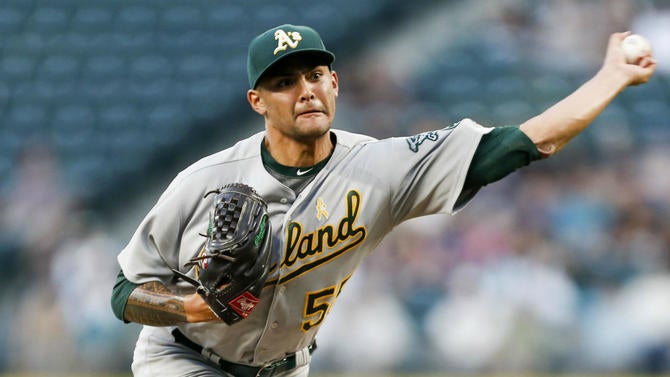
Moneybullpen
Rather than address the rotation by adding a mid-rotation type or two, the A's spent the winter rebuilding their bullpen.
The process actually began last summer, when the A's acquired Blake Treinen and Chris Hatcher, each possessing power arms and poor statistics. Oakland went on to add Yusmeiro Petit, Emilio Pagan, and Ryan Buchter through free agency and trades. Those aren't household names, yet they're each coming off highly effective seasons:
The A's have added Buchter, Petit and Emilio Pagan as they try to go for the "quietly good xwOBA relievers you never heard of" title in 2018.
— Mike Petriello (@mike_petriello) January 30, 2018
Plus: I have talked to both Liam Hendricks and Chris Hatcher in the past and I am in the can for both of their fastballs. Go @Athletics.
It's worth noting that Petit (91 innings in 60 appearances) and Pagan (50 in 34) both flourished in multi-inning roles, so there's a chance the A's take some pressure off their young, unpredictable rotation by leveraging those two for multiple frames as they try to build a bridge to the late innings.
Will that work? Unclear. But count the A's among the teams who are counting on their bullpen to do more lifting in 2018. The best case scenario sees Oakland serving as the west-coast version of the Baltimore Orioles squads who slugged and relieved their way to the postseason. That doesn't sound like a thrilling outcome, but it beats a fourth consecutive last-place finish.
Probable lineup
- SS Marcus Semien
- LF Matt Joyce
- 2B Jed Lowrie
- DH Khris Davis
- 1B Matt Olson
- RF Stephen Piscotty
- CF Boog Powell
- 3B Matt Chapman
- C Jonathan Lucroy
Bench: C Josh Phegley, UTL Chad Pinder, OF Jake Smolinski
Probable rotation
- RHP Kendall Graveman
- LHP Sean Manaea
- RHP Daniel Mengden
- RHP Andrew Triggs
- RHP Paul Blackburn
Probable bullpen
Closer: RHP Blake Treinen
Setup: RHP Chris Hatcher, RHP Liam Hendriks
Middle: RHP Yusmeiro Petit, RHP Emilio Pagan, RHP Santiago Casilla, LHP Ryan Buchter












